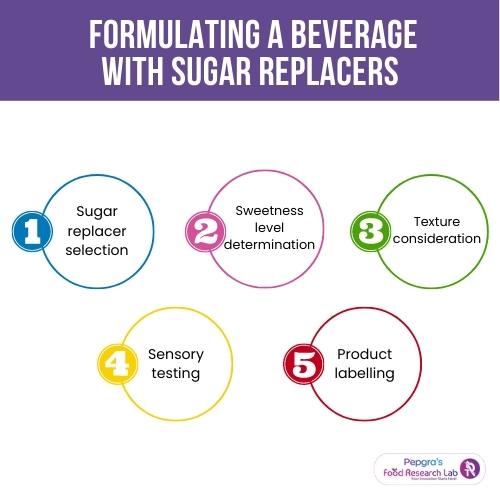
Formulation of Beverage with Sugar Alternatives
Introduction
The burden of chronic diseases and conditions like type-2 diabetes, cardiovascular diseases, and obesity is increasing, and nearly 30% of the world’s population are overweight or obese. According to the World Health Organisation (WHO), tooth decay and excess weight gain are the health outcomes of sugar consumption. About 25% of the total caloric intake (2,000 Kcal) comes from sugar, which is way higher than the recommended level of WHO, which is 10%. Sugar-sweetened beverages are the highest contributors of sugar; about 80% of youth and 63% of adults consume sugar-sweetened beverages, according to a study by Wang and Bleich et al. [1].
Additionally, many national and international health organisations emphasise reducing the total dietary sugar intake to prevent and manage chronic health conditions. Therefore, the food and beverage industries seek alternative ingredients or sugar replacers that can produce sweetness and functionality as sugar [2].
Formulating a beverage using sugar replacers

Formulating a beverage product using sugar replacers requires several steps to achieve the desired taste and texture. Here are some general guidelines to consider:
- Choose the right sugar replacers: Various sugar replacers are available in the market, each with different properties and sweetness levels. Therefore, it is essential to select the appropriate replacers based on the desired taste, texture, and application of the product. Common sugar replacers include stevia, erythritol, xylitol, allulose, and monk fruit extract.
- Determine the sweetness level: Sugar replacers with no/low calories have different sweetness levels than table sugar. Hence, determining the appropriate amount of replacers needed to replace the sugar in the recipe to achieve the desired sweetness level is vital [3].
- Consider the texture: Sugar plays a significant role in the texture and mouthfeel of the product. Replacing sugar with sugar replacers may impact the texture and result in a different mouthfeel. Therefore, it is crucial to consider the type of sugar replacer used and its impact on the texture. For example, a class of sugar replacers called fibre-based sweeteners bring texture while reducing the caloric content of the drink. Soluble fibres like inulin and its derivatives like pectin and resistant dextrin are used for this purpose [2].
- Conduct taste tests: A study by Lima et al. demonstrated that the sensory perception of a beverage is preferred over the nutritional profile. Therefore, after formulating the product, it is essential to conduct sensory tests to ensure it meets the desired taste and texture. This will also help identify any necessary adjustments in the recipe and reduce any challenges that occur during sensory evaluation.
- Label the product correctly: When using sugar replacers in beverage formulation, it is important to correctly label the product to inform consumers about the use of sugar replacers and their potential health benefits [4].
Conclusion
The food and beverage industries must understand consumer preferences while innovating a new product/reformulating an existing product. For instance, formulating a beverage product using sugar replacers requires carefully considering the type and amount of replacers used, their impact on texture and taste, and conducting taste tests to ensure the product meets the desired taste and texture.
How the Food Research Lab can Help
The Food Research Lab develops ingredients for its clients. The team of experienced experts in our facility are updated with the latest trends. We help develop high-quality ingredients and ensures they are free of contamination. In addition, we conduct cost analysis so that the ingredients are formulated at an economical price.





